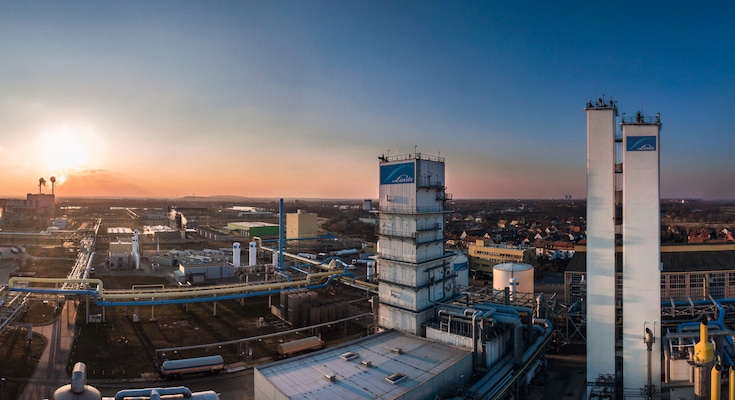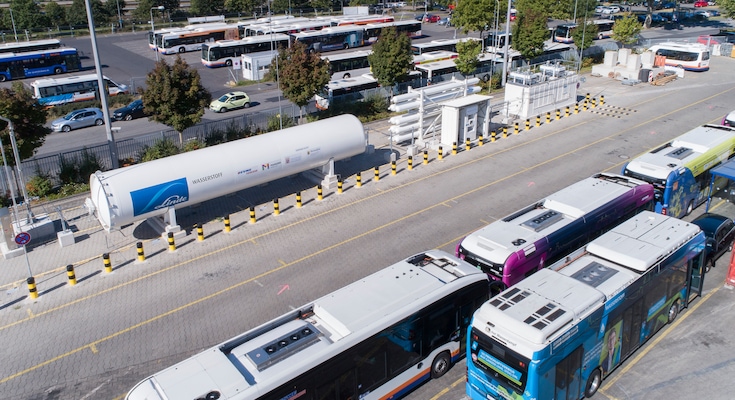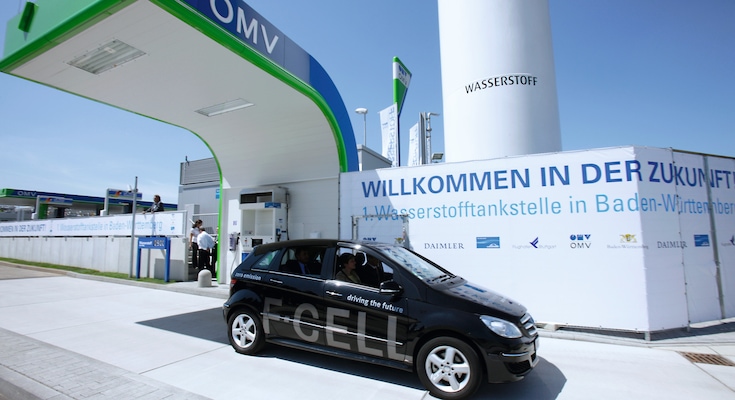
A showcase of Linde’s hydrogen business and integrated H2 value chain.
Linde is the only company to cover every step in the hydrogen value chain from production and processing through distribution and storage to everyday industrial and consumer applications. Building on decades of research and countless real-world projects, Linde’s hydrogen capabilities demonstrate its innovative power and proven expertise in delivering workable, economically viable hydrogen technologies suited to mass deployment.
Demand for hydrogen technologies is rising. It has the potential to accelerate the transition to more sustainable forms of energy while still supporting current energy models with all their regional variations.
Hydrogen is a zero-emissions source of fuel for trains, buses and cars. It can be used as a feedstock gas for industries such as chemicals, refining and steel. In addition, it is a source of heat and power for buildings and can buffer energy generated from renewable sources.
Hydrogen can be generated from natural gas and other non-renewable by-products. In addition, it can be used as an energy vector; in other words, a medium to store energy from renewable and other sources. Looking to the future, it can be generated at scale with a zero-carbon footprint by using renewable energy such as solar or wind power, for instance, to split water (electrolysis).

Steam reforming is the main method used to produce hydrogen on an industrial scale today. In an initial step, feedstocks such as natural gas, LPG or naphtha are combined with steam to produce synthesis gas with the aid of a heterogeneous catalyst. This mixture of carbon monoxide and hydrogen is then further processed. Since fossil fuels are used in this production method, the end product is called gray hydrogen. Gray hydrogen can also be produced through the partial oxidation of refinery residues. This residue material is heated to a very high temperature with oxygen and steam to produce a raw synthesis gas. If the carbon dioxide contained in this gas is removed in a downstream carbon capture process, the resulting hydrogen is called blue hydrogen. Green hydrogen is obtained either by steam reforming, if bio-based feedstock is available, or by splitting water by electrolysis. The electricity needed for this electrolysis process is generated exclusively from renewable sources.

Steam reforming initially produces synthesis gas - a mixture of hydrogen and carbon monoxide and carbon dioxide. We offer cryogenic processes (condensation or methane scrubbing) to separate these two gases post CO2 removal. Pressure swing adsorption plants are used to obtain H2 from hydrogen-rich synthesis gases or refinery and petrochemical gases. We have also developed an alternative hybrid process where we combine membrane and pressure swing adsorption (PSA) technologies for new-found levels of flexibility and efficiency in the production of H2. The PSA system can also be used to remove or recover carbon dioxide from process gas streams at synthesis gas plants. CO2 can also be recovered from the flue gas of hydrogen plants by Post Combustion Capture (PCC). RECTISOL® wash is a physical acid gas process for segregated removal of sulfur and CO2 from the synthesis gas at subzero temperatures. The use of low-energy coil-wound heat exchangers makes this a particularly economical gas purification method. Where needed, the captured CO2 can be used for enhanced oil recovery (EOR) or fed into a purification or liquefaction plant to enable further use cases. Linde can also offer synthesis plants for the production of ammonia (NH3) or methanol (CH3OH) by converting the produced hydrogen and nitrogen, or syngas stream. These products may be called green ammonia or green methanol if green hydrogen is utilized as a feedstock. Cryogenic plants are used to liquefy hydrogen so it can be transported and stored efficiently. They cool the volatile gas down to minus 253 degrees Celsius to create liquefied hydrogen (LH2). This process increases the density of the gas. In addition, we offer turbocompressors for hydrogen and LH2 pumps. We supply this equipment as part of integrated offerings for our customers’ hydrogen projects.

A pipeline network is probably the best option if multiple customers on an industrial site require hydrogen. Several production facilities can feed H2 into the network and it, in turn, can supply the gas to multiple customers at different locations. Cryogenic tanks can be provided to store the hydrogen if it is not going to be used directly. The liquid hydrogen (LH2) is efficiently stored in vacuum-insulated tanks which can be installed either vertically or horizontally. Different capacities are available, ranging from 3,000 liters to over 100,000 liters. We also offer our customers transportable LH2 containers with active cooling. This guarantees extended storage windows combined with maximum safety. For bulk storage of gaseous hydrogen, underground salt caverns are an option. The gas has to be purified and compressed before it can be injected into the cavern. Hydrogen-filled cavities can act as a backup for a pipeline network. A cavern of this type is already operated by Linde on a commercial basis in Texas. Another transportation option for hydrogen is to deliver it to the point of use in converted form, i.e. as ammonia or methanol.

Hydrogen is also the key to a more environmentally friendly mobility ecosystem. Linde Hydrogen FuelTech provides high-performance refueling concepts and technologies and is thus paving the way for end-to-end hydrogen infrastructures. Over 190 H2 fueling stations around the world are already equipped with our technology. This makes us the market leader for fast, efficient and successful hydrogen refueling solutions. Our compression technologies are at the heart of every H2 fueling station. Ionic technology is used to compress gaseous H2 to up to 100 MPa and the Cryo Pump efficiently supplies hydrogen in liquid form ready for refueling. We can adapt both systems to customers’ individual requirements. Now that our fueling technologies have clearly reached market maturity, we are the first company worldwide to launch small-series production of H2 fuel stations.
In our podcast series on hydrogen, experts discuss innovative developments and market trends, as well as Linde’s unique hydrogen value chain.
“Blue hydrogen is the next step. That’s gray hydrogen combined with taking as much as possible of the CO2 out of the equation. So combining the technology of, for example, steam methane reforming with CO2 sequestration, and Linde has the technology to do that.”
“To produce huge amounts of green hydrogen, special technologies are necessary, and Linde is betting on proton exchange membrane technology, or simply PEM. That’s the technology where we believe we’ll deliver the quantities of hydrogen that we are going to require as we transition to the kind of zero-emission future that is going to be required for us to meet our commitments under the Paris Accords.”
“The technology which our experts have developed, which is called Cryo Pump technology, compresses the liquid hydrogen in two stages. This brings it ’to the target pressure of 90 megapascal. We then warm it up to ambient temperature and store it or fill it directly into the car. And by using that technology, we save a lot of electrical energy at the station because we don’t need electrical energy to cool down the hydrogen. This represents a a significant saving when it comes to frequent fuelings.”
“Low-carbon hydrogen can be achieved today. And it is important in bridging the gap between gray hydrogen and green hydrogen. And that is where Linde comes into the picture, bringing technologies together to produce hydrogen as efficiently and with as little CO2 as possible.”

A showcase of Linde’s hydrogen business and integrated H2 value chain.

Linde is driving hydrogen fueling projects in the local transit space.

Refineries and petrochemical groups are looking to a future powered by H2.

Hydrogen (H2) offers huge potential as a green fuel. In liquid form, it has an even higher energy density. Linde provides both gaseous and liquid fueling technologies.

Access Recorded Seminars for Free!
Gray hydrogen is obtained from fossil fuels. Steam reformers are used to convert natural gas, for instance, by means of steam addition. The resulting hydrogen-rich synthesis gas is then further processed. During the gray H2 generation process, the carbon dioxide (CO2) by-product escapes into the atmosphere. By contrast, with blue hydrogen, the CO2 is captured in a downstream process. And green hydrogen is produced exclusively from renewable sources. However, so far it has not been possible to produce the green variant of H2 in sufficient quantities.
Hydrogen can smooth the transition to a more sustainable energy economy. Not only can H2 be used as a zero-emission fuel for trains, buses, trucks, automobiles and ships, but also as a feedstock for various industries including chemicals, refining and steelmaking. In addition, hydrogen can provide a source of energy and heat for buildings and can store energy produced from renewable sources.
This technology works by physically binding gas molecules to an adsorbing material. The binding force between the molecules and the adsorbent depends on a number of factors, including the type of gas. This binding process creates a separation effect. Unlike carbon monoxide (CO), carbon dioxide (CO2) and nitrogen (N2), highly volatile components with low polarity like hydrogen have a negligible binding force. So while the impurities adhere to the adsorbent, hydrogen is able to flow right through.
A wide range of industries including metalworking, medical technology, electronics and food processing use liquefied gases. These gases are always supplied to customers in liquid form so that they can be stored on site for later use. That is why we deliver not only cryogenic solutions for the liquefaction of H2 but also suitable tanks for reliable and efficient storage. The inner tanks and piping systems are manufactured from stainless steel to guarantee a high purity grade. This is particularly important for the foodstuff and electronics industries. The outer shell has a special coating that guarantees excellent insulation from ambient effects.
Instead of using a metal compression piston, this process works with an ionic liquid. More specifically, the liquid is an organic salt which behaves like a solid in the compression process. The ionic liquid acts as a lubricant and a refrigerant at the same time. Being anti-corrosive, it reduces maintenance costs and is significantly more efficient than conventional compressors.
They are used to convert liquid hydrogen cooled to minus 253 degrees Celsius into high-pressure hydrogen. This enables H2 vehicles to be quickly and efficiently refueled from a storage tank containing liquid hydrogen. The direct compression of LH2 hugely reduces the energy consumption of a hydrogen fueling station because the cooling capacity of liquid hydrogen means that no additional cooling power is needed for the compression process.
Linde has engineered and built 200 hydrogen refueling stations. As such, we have the biggest installed base and the most experience worldwide. Cars, buses and forklifts have already refueled far over 1.5 million times using our technology. Today, we are building major bus depots in various locations around the world. We also supplied the world’s first H2 station for passenger trains.
Hydrogen-powered cars can be refueled with Linde’s proprietary compression technologies in three to five minutes. They can drive up to 800 kilometers before needing to refuel.
Our highly efficient patented Ionic Compressor gradually brings hydrogen to a pressure of 900 bar so it can be used to fuel 700-bar tanks of fuel-cell electric vehicles (e.g. passenger cars).
Yes, we have been serving buses for some time now and we are currently building the world’s very first HRS for passenger trains. In 2011, for example, a hydrogen fueling station for buses operated by the company AC Transit opened up in Emeryville, California. That was the first time that our Ionic Compressor was used in the US for the refueling of buses. Local transit (or public transport) is one of the important focus applications for hydrogen, and we are involved in numerous projects that are advancing developments in this field. Many more bus fueling stations have since been installed and the trend is upward – worldwide. We have pioneered many of the enabling technologies and are engaged in several groundbreaking projects. These include the fueling of hydrogen trains developed by the company Alstom. The Coradia iLint is the world’s first passenger train powered by fuel cells and H2. We are currently building a hydrogen fueling station for twelve Coradia iLints in Bremervörde, Germany. The facility has a capacity of around 1,600 kilograms of hydrogen a day, making it one of the world’s largest hydrogen fueling stations.
Our custom-developed, patented Ionic Compressor uses five hydraulic pistons to gradually compress the hydrogen to a pressure of either 500 bar or 900 bar. The right outlet pressure depends on the vehicles to be refueled. Buses, trains and trucks mainly require 350 bar tanks whereas passenger cars work with 700 bar.
Yes, Linde is driving the technology and infrastructure innovations needed to accelerate the transition to greener forms of hydrogen Demand for clean hydrogen has risen significantly in recent years. This transition is enabled largely by water electrolysis, using electricity to split water into hydrogen and oxygen. So, we formed a joint venture with ITM Power. Together with this joint venture, we will operate the worlds largest Proton Exchange Membrane electrolysis plant in Leuna, Germany, producing 4,500 standard cubic meters of hydrogen every hour. Since the PEM electrolyzer is predominantly powered by nearby renewable energy sources, the site will produce up to 3,200 metric tons of green hydrogen per year. This is sufficient to power around 600 fuel-cell buses, enabling them to travel 40 million kilometers while saving up to 40,000 tons of carbon dioxide emissions per year. Leuna has become an important reference and we continue to work on more and larger projects globally and for customers of all relevant market segments.
For us, promoting hydrogen mobility also means making it easier for this clean fuel to enter the infrastructure. That’s why we developed a mobile fueling station called FuelBox which is compact and transportable. It is equipped with our proven Ionic Compressor technology. With the FuelBox, 350 kilograms of hydrogen can be refueled per day. The unit is available in two pressure levels: the 350-bar option enables heavy-duty vehicles to be refueled ten times per day. With the 700-bar variant for cars, 65 vehicles can be refueled with hydrogen every day. This ready-to-use equipment can be stored in two containers stacked on top of each other and therefore only needs floor space of twelve square meters. Only a foundation plate is required on site. The system can be installed immediately at almost any location. The FuelBox is designed for fast, highly efficient refueling times, ease of use and high capacities. For customers who want to test their fuel-cell vehicle fleets or who want to test their hydrogen infrastructure in terms of performance, the FuelBox is an optimal solution. The new CE-certified system is designed for the European market and can also be used as a permanent refueling unit.